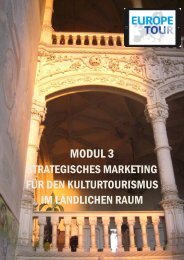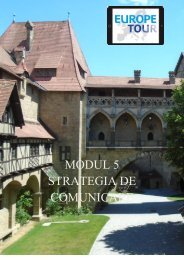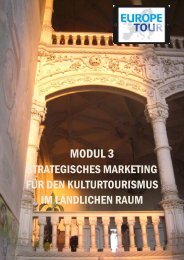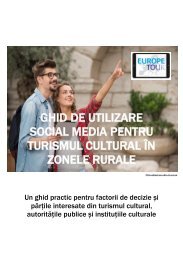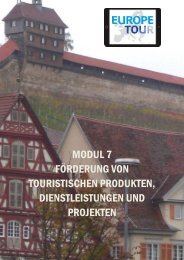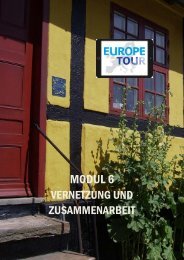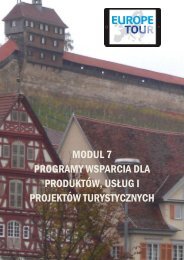M5_Communication_Strategy_v6
You also want an ePaper? Increase the reach of your titles
YUMPU automatically turns print PDFs into web optimized ePapers that Google loves.
CULTURAL TOURISM TRAINING COURSE<br />
MODULE 5 - COMMUNICATION STRATEGY<br />
Corporate Identity<br />
Corporate Identity (CI) can be regarded as the roof of communication because it deals with the central<br />
concern of each communication, message, or question: What do you want to communicate? It is closely<br />
related to your mission statement and must not contradict it.<br />
Therefore, having an understanding of your own, specific Corporate Identity is one of the most important<br />
tasks. In this context, we must first and foremost point to the close relation between “image”<br />
and “identity”.<br />
Image is the understanding, expectation and opinion of persons (subjects) in relation to certain products<br />
and services (objects). In tourism, you will be mostly interested in the image of destinations. The<br />
picture of a holiday destination that a potential visitor has in her/his mind is one of the most decisive<br />
elements for the selection of the destination. Positive images will lead to positive decisions, negative<br />
images, even from one single element of the entire destination, will lead to the decision to select another<br />
destination.<br />
In order to be successful, it is important to distinguish between “self-image” and “external image”. The<br />
self-image is the result of your self-assessment; external image is the assessment from outside through<br />
the visitor. It is his subjective copy of the original, and it is created based on conscious and subconscious<br />
communication between the sender and the receiver. Only very rarely are self-image and external<br />
image identical. This is an important concept to keep in mind!<br />
An image consists of two components:<br />
The cognitive component, concerning the knowledge about the product or service, e.g. the knowledge<br />
about a certain destination due to previous travel experience.<br />
The affective or emotional component focuses on feelings, attitudes and needs for the subjective imagination.<br />
It contains diffuse sympathies, antipathies or prejudices towards a destination or people that<br />
have been created through one’s own travel experiences or traditional thinking patterns or opinions of<br />
other people and media.<br />
In cultural tourism, images play a similarly big role as in consumer goods.<br />
17




